Aug 01, 2006
Freq2
From Networked Performance (via Pixelsumo]
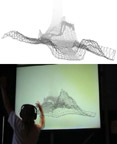
Freq2, by Squidsoup, uses your whole body to control the precise nature of a sound - a form of musical instrument. The mechanism used is to trace the outline of a person's shadow, using a webcam, and transform this line into an audible sound. Any sound can be described as a waveform - essentially a line - and so these lines can be derived from one's shadow. What you see is literally what you hear, as the drawn wave is immediately audible as a realtime dynamic drone.
Freq2 adds to this experience by adding a temporal component to the mix; a sonic composition in which to frame the instrument. The visuals, an abstract 3-dimensional landscape, extrudes in realtime into the distance, leaving a trail of the interactions that have occurred. This `memory' of what has gone before is reflected in the sounds, with long loops echoing passed interactions. The sounds, all generated in realtime from the live waveform, have also been built into more of a compositional soundscape, with the waveform being played at a range of pitches and with a rhythmic component.
Watch video
11:39 Posted in Cyberart | Permalink | Comments (0) | Tags: cyberart
Oribotics
via textually.org
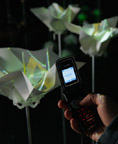
Oribotics - by Matthew Gardiner - is the fusion of origami and technology, specifically 'bot' technology, such as robots, or intelligent computer agents known as bots. The system was designed to create an intimate connection between the audience and the bots; a cross between gardening, messaging a friend, and commanding a robot. It was developed during an Australian Network for Artists and Technology (ANAT) artists lab; achieved with Processing as an authoring tool, and connected a mobile phone via a USB cable.
"Ori-botics is a joining of two complex fields of study. Ori comes from the Japanese verb Oru literally meaning 'to fold'. Origami the Japanese word for paper folding, comes from the same root. Oribotics is origami that is controlled by robot technology; paper that will fold and unfold on command. An Oribot by definition is a folding bot. By this definition, anything that uses robotics/botics and folding together is an oribot. This includes some industrial applications already in existance, such as Miura's folds taken to space, and also includes my two latest works. Orimattic, and Oribotics."
11:38 Posted in AI & robotics, Cyberart | Permalink | Comments (0) | Tags: cyberart
Jul 25, 2006
Interactive Dance Technology
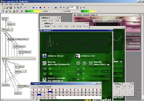
Within the field of interactive dance technology, a number of projects have experimented with dancers producing music in real time from their body movements, as opposed to following the music. In MusicViaMotion (2000) for example, dance movements are captured with a video camera and mapped to sound synthesis in real time. In MIT Medialab's Expressive Footwear project (1998) and Katherine Moriwaki's Music Shoes (2000), the dancers wear sport shoes respectively chinese slippers, equipped with a range of sensors. In Alfred Desio's Zapped Taps, sensors are also used, this time on tap shoes. In all these projects, the sensed movements actuate and modulate artificial sounds.
22:16 Posted in Cyberart | Permalink | Comments (0) | Tags: cyberart
Feb 14, 2006
Perfectly normal

PerfectlyNormal is an interactive web-based video project that offers fourteen short video-based therapies. Depending on the "patients'" auto-description of their mental state, the web site automatically delivers one therapeutic video. According to the website disclaimer, the video-therapies were developed following principles of actual healing techniques derived from several different practices.
PerfectlyNormal is a web-based project commissioned by Soil Digital Media Suite, Neutral Ground Gallery, Regina, Saskatchewan, Canada. The project's author is composer and new media artist Michael Stecky (read short bio).From the project's website:
Bringing a unique healing experience, PerfectlyNormal, provides you and your family with the best integrated mental health care model the internet has to offer. Receive a personalized video therapy from our collection, a virtual one-stop shop of the best conventional and alternative practices from a diverse and interesting range of modalities.
PerfectlyNormal is an easy to use healing site made to work with you in mind. Visit when you like, PerfectlyNormal is available to you 24 hours a day, everyday. Now, feeling normal is only a mouse click away. PerfectlyNormal, have a perfect day everyday. PerfectlyNormal comes to you courtesy of the PerfectlyNormal Therapeutic Cooperative Alliance (PNTCA), a prestigious international group of like-minded therapists who share an inclusive spiritual philosophy.
11:25 Posted in Cyberart | Permalink | Comments (0) | Tags: Positive Technology, cyberart
Jan 28, 2006
Telepresence and Bio Art
Via Boing-Boing
For nearly two decades Eduardo Kac has been at the cutting edge of media art, first inventing early online artworks for the web and continuously developing new art forms that involve telecommunications and robotics as a new platform for art. Interest in telepresence, also known as telerobotics, exploded in the 1990s, and remains an important development in media art. Since that time, Kac has increasingly moved into the fields of biology and biotechnology.
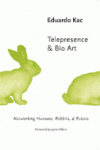 Telepresence and Bio Art is the first book to document the evolution of bio art and the aesthetic development of Kac, the creator of the "artist's gene" as well as the controversial glow-in-the-dark, genetically engineered rabbit Alba. Kac covers a broad range of topics within media art, including telecommunications media, interactive systems and the Internet, telematics and robotics, and the contact between electronic art and biotechnology. Addressing emerging and complex topics, this book will be essential reading for anyone interested in contemporary art. Artist Eduardo Kac is internationally recognized for his interactive Internet installations and his bio art. A pioneer of telecommunications art in the pre-web '80s, Kac emerged in the early '90s with his radical telepresence and biotelematic works.
Telepresence and Bio Art is the first book to document the evolution of bio art and the aesthetic development of Kac, the creator of the "artist's gene" as well as the controversial glow-in-the-dark, genetically engineered rabbit Alba. Kac covers a broad range of topics within media art, including telecommunications media, interactive systems and the Internet, telematics and robotics, and the contact between electronic art and biotechnology. Addressing emerging and complex topics, this book will be essential reading for anyone interested in contemporary art. Artist Eduardo Kac is internationally recognized for his interactive Internet installations and his bio art. A pioneer of telecommunications art in the pre-web '80s, Kac emerged in the early '90s with his radical telepresence and biotelematic works.
19:40 Posted in Cyberart | Permalink | Comments (0) | Tags: Positive Technology, cyberart
Oct 31, 2005
Alzheimer's Art therapy
via Neurodudes
The New York Times reports about visual-art therapy, an approach which seems to have positive effects on Alzheimer's brain disease. Though it has long been known that music has beneficial effects in the rehabilitation of brain-injured patients, the potential role of visual arts has not been systematically explored so far. 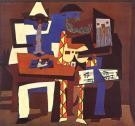 According to neurologist and scientis Oliver Sacks, an aesthetic encounter is not just a visual experience, but involves the activation of emotions; further, he observes that demented patients can recognize and respond vividly to paintings, while they are scarcely responsive to words and disoriented and out of it
According to neurologist and scientis Oliver Sacks, an aesthetic encounter is not just a visual experience, but involves the activation of emotions; further, he observes that demented patients can recognize and respond vividly to paintings, while they are scarcely responsive to words and disoriented and out of it
read NYT full article
18:05 Posted in Cyberart | Permalink | Comments (0) | Tags: Positive Technology, cyberart
Sep 23, 2005
Media Fabrics
Interactive Cinema - Media Fabrics is a research initiative at MIT that focuses on a new paradigm: the "media fabric" - a semi-intelligent organism where lines of communication, 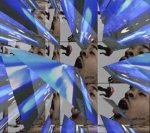 threads of meaning, chains of causality, and streams of consciousness converge and intertwine to form a rich tapestry of creative story potentials, meaningful real-time dialogues, social interactions, and personal or communal art- and story-making.
threads of meaning, chains of causality, and streams of consciousness converge and intertwine to form a rich tapestry of creative story potentials, meaningful real-time dialogues, social interactions, and personal or communal art- and story-making.
More to explore
The Media Fabrics website
13:35 Posted in Cyberart | Permalink | Comments (0) | Tags: Positive Technology, cyberart






